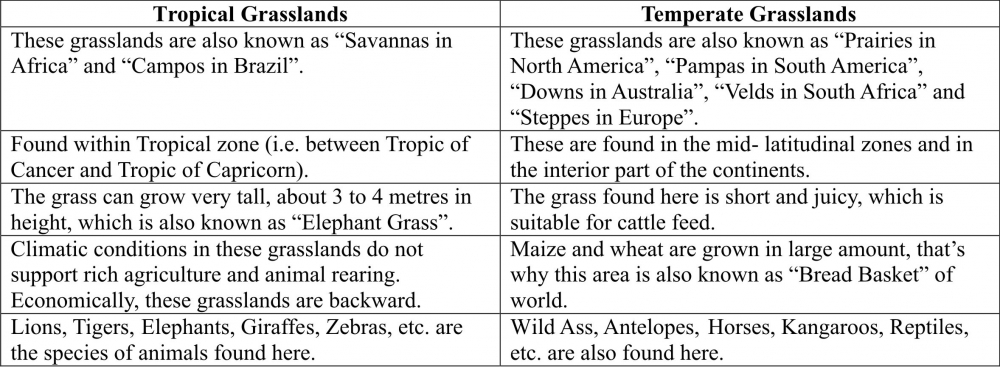Class VIII: Chapter 3 (Natural Resources: Natural Vegetation & Wildlife) Question & Answers
Write three examples of each of the following
Q1. Trees found in equatorial forest.
Ans: Trees found in equatorial forest are Rosewood, Ebony, and Mahogany.
Q2. Trees found in taiga forest.
Ans: Trees found in taiga forest are Douglas-Fir, Larch and Redwood.
Q3. Animals found in Africa.
Ans: Animals found in Africa are Elephants, Zebras and Camels.
Q4. Animals found in Europe.
Ans: Animals found in Europe are Polar Bears, Minks and Sables.
Short Answer Questions
Q5. What are the main characteristics of coniferous forest?
Ans: Following are the main characteristics of coniferous forest:
• Limited species of trees are found. These trees are evergreen and grow apart from each other.
• Trees are conical shaped with needle shaped leaves and trees are found in large groups.
• Chir, pine, cedar are the important variety of trees in these forests. Lumbering is the common activity. Soft wood is used for manufacturing paper.
• Fur-bearing animals like Silver fox, mink, and polar bear are the common animals found here.
Q6. Distinguish between tropical and temperate grasslands.
Ans:

Q7. Explain the effects of clearance and destruction of natural vegetation.
Ans: The clearance and destruction of natural vegetation has led to major environmental issues. Following are its effects:
(a) Global warming.
(b) Decrease in rainfall.
(c) Soil erosion on a very large scale.
(d) Decrease in underground water.
(e) Decrease in wildlife, as their habitats are destroyed.
(f) Decrease in tribal population, as their habitats are destroyed. Etc.
Q8. What are the role of CITES in saving the flora and fauna?
Ans: CITES (the Convention on International Trade in Endangered Species of Wild Fauna and Flora) is an international agreement between governments. Its aim is to ensure that international trade in products of wild animals and plants does not threaten their survival.
Long Answer Questions
Q9. Define – natural vegetation, Wildlife, Ecosystem, Taiga and Deforestation.
Ans:
(a) Natural Vegetation: Natural vegetation refers to a plant community which has grown naturally without human aid and has been left undisturbed by humans for a long time.
(b) Wildlife: Animals living in their natural habitat and not within the possession or control of humans.
(c) Ecosystem: Interrelation between plants and animals in the natural environment is called Ecosystem.
(d) Taiga: coniferous forests are also called "Taiga Forest". This forest belt extends from 50oN and 70oN latitudes. Trees found here are conical shaped with needle shaped leaves.
(e) Deforestation: Deforestation is the cutting down of trees on a large scale from an area with no intention of replanting the trees. Deforestation is one of the main cause of environmental disorder.
Q10. Describe the natural vegetation in hot and cold deserts.
Ans:
(a) Hot Deserts: Natural vegetations found in hot deserts have thick & spongy stems, long roots, wax coated leaves, thorns, etc. Cactus, thorny bushes and coarse grass are main type of vegetation found here. At some places palm trees can be found surrounding the Oasis.
(b) Cold Deserts: In these deserts trees are not found; as trees don't grow below 10° C. Very less vegetation is found. Mosses, Lichens and some shrubs grow here. At some places meadows (short grass cover ground) can also be found.
Q11. Name the typical wildlife found in each continent.
Ans: Some of the typical wildlife found in continents are:
(a) Africa: Elephants, crocodiles, zebras, leopards, camels and ostriches.
(b) Antarctica: Penguins, snow petrels, seals and albatrosses.
(c) Asia: Monkeys, sloths, lynxes and minks.
(d) Australia: Kangaroos, koalas and kookaburras.
(e) Europe: Polar bears, minks, sables and ermines.
(f) North America: Reindeer, arctic foxes, bisons and beavers.
(g) South America: Rheas, condors, anteaters, llamas and anacondas.
Q12. What are the initiatives taken to conserve natural vegetation and wildlife?
Ans: Following are few steps that have been taken to conserve forest and wildlife:
(a) National Forest Policy framed by the government should be implemented.
(b) National Parks, Wildlife Sanctuaries, Bioreserves, Botanical Gardens have been setup.
(c) Special Projects (E.g. Project Tiger, Project Elephant, etc.).
(d) Celebration of Van Mahotsav.
(e) Every National festival is followed by tree plantation ceremony.
(f) Large scale afforestation or planting of tress is undertaken.
(g) Controlling of deforestation and overgrazing.
(h) Practices like shifting agriculture have been stopped.
(i) Social Awareness Programmes to be implemented.
(j) Wildlife Protection Act 1972.
-----x-----X-----x-----

There are no published comments.
New comment